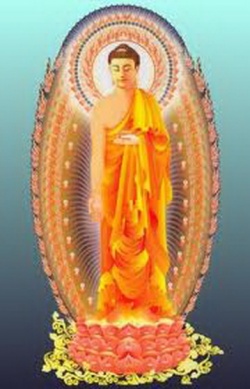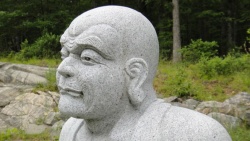Atisha Dipankara Srijnana
Atisha Dipankara Srijnana, a great Buddhist saint-philosopher of 10th-11th century, least known in India, has been venerated as an outstanding personality in Asian countries especially in the Himalayan region. He has been a symbol of peace, compassion, humanism, self sacrifice, harmony and amity who devoted his energies in the dissemination of Dhamma to Universities of Odantapuri, Vikramasila, Sompuri, Nalanda and institutions of excellence and monastic complexes. He played a significant role in infusing wisdom and resurgence of Buddhism and laying its foundation in pure form. His philosophy has brought significant changes among monks as well as the common people in the concept of their moral purity, self sacrifice, nobility of character, idealism and revolutionized the social, religious and cultural lives of the people. The people and the kings of Tibet invited him to reform the religious and social condition of Tibet at that time.
It is generally believed that he was borne in the village Vajrayogini in the Bikrampur region of Bengal, currently in Bangladesh, in 982 CE. Accounts of the spiritual teacher’s life are found in 44 Tibetan texts—biographies, doctrinal works, catalogues and hymns written in praise. His birth in the year 980/982 also saw a major power shift in Bengali politics as the resurgent Pala dynasty seized control of the region, disposing of the incumbent Kamboja rulers. His childhood name was Chandragarbha. From a very young age he showed an extraordinary aptitude for spirituality and studied sincerely under more than 100 teachers. He received, practiced, and mastered the instructions on the Theravada, Mahayana, and Vajrayana schools of Buddhism and was regarded highly by all the traditions of Buddhism in India at the time
Atisha had studied sixty-four kinds of arts including music and logic, and accomplished them by the age of twenty two. According to Tibetan sources, Atisha was ordained into the Mahasamghika lineage at the age of twenty-eight by the Abbot Silaraksita and studied almost all Buddhist and non-Buddhist schools of his time, including teachings of Vaisnavism, Saivism, Tantrism. He studied, practiced and transmitted the three main lineages of Buddhism.
At the age of thirty-one, Atisha with 100 disciples set off on a perilous journey, travelling for thirteen months to Sumatra in order to study under the reputable Suvarnadvipi Dharmakirti, sometimes called Dharmaraksita and known in Tibetan as Serlingpa (Wylie:Gser-gling-pa), a supposed master of bodhichitta. Goddess Tara was his guiding spirit and continued to be so until the end of his life. Under the guidance of Dharmaraksita, Atisha remained there for twelve years. Finally, after over a decade of intensive training, Dharmaraksita advised him to "go to the north, to the Land of Snows." From his Master, Dharmaraksita, Atisha learnt one meditation that became one of the Tibetans fundamental meditation techniques, i.e. Tongleng Meditation that aims to recycle supposedly negative energy into loving and healing energy.
He then returned to Magadha where he met great Buddhist scholars who all acknowledged his superior knowledge and scholarship. Soon enough he was appointed to the position of steward, or abbot, at the Vikramasila University. Atisha's rise to prominence coincided with a flourishing of Buddhist culture and the practice of Dharma, and in many ways Atisha's influence contributed to these developments.
In the 11th century, the Tibetan king byang-chub 'Od invited Atiśa. He entered Tibet in an age when monastic Buddhist tradition of Tibet had been nearly wiped out after King Langdarma's intolerant reign. He has been an important figure for last ten centuries in the Tibetan Buddhist tradition because he revived, refined, systematized, and compiled an innovative and thorough approach to bodhichitta known as "mind training" (Tib. lojong), in such texts as A Lamp for the Path to Enlightenment, and established its primacy to the Mahayana tradition in Tibet. Atisha's closest disciple, Dromtönpa, is considered the founder of the Kadam school, which later evolved into the Gelug, one of the four main schools of Tibetan Buddhism.
Atiśa wrote, translated and edited more than two hundred books from Sanskrit into Tibetan to spread Buddhism. He also wrote several books on Buddhist scriptures, medical science and technical science in Tibetan. Several books written by him in Sanskrit are extant only in Tibetan translations now. 79 of his compositions have been preserved in Tibetan translation in the Tanjur (bstan-sgyur). Some of them are Bodhi-patha-pradipa, Charya-sanggraha-pradipa, Satya-dvayavatara, Bodhi-sattva-manyavali, Madhyamaka-ratna-pradipa, Mahayana-patha-sadhana-sanggraha, Siksa-samuchchaya Abhisamya, Prajna-paramita-pindartha-pradipa, Ekavira-sadhana and Vimala-ratna-lekha.
In Tibet after staying at Ngari, he went to Samye where he discovered the store of Sanskrit texts at Pekar Kordzoling, the library. The degree to which the Vajrayana had spread in Tibet was unparalleled, even in India. Dromtonpa, the principal disciple of Atiśa kept the complete legacy of Atiśa and this became later known as the Kadampa (Bka'-gdams-pa) tradition of Buddhism. This was later revived by the Tibetan teacher Tsongkhapa (Btsong-ka-pa), the founder of the Gelug (Dge-lugs) tradition. Since that time the Kadampa school of Atiśa is named Old Kadampa and Tsongkhapa's Gelug school is named New Kadampa.
As Atisha grew old, he moved to explore Central Tibet. Atisha spent nine years in Nyetang, a town near Lhasa, where he discovered Tibetan libraries with impressive collections written in both Sanskrit and Tibetan. The venerable monk moved around the region for another five years before passing away in 1052 at the prophesied age of seventy-two in a village called Lethan, near Lhasa. He was enshrined near his last permanent home in the town of Nyetang.

